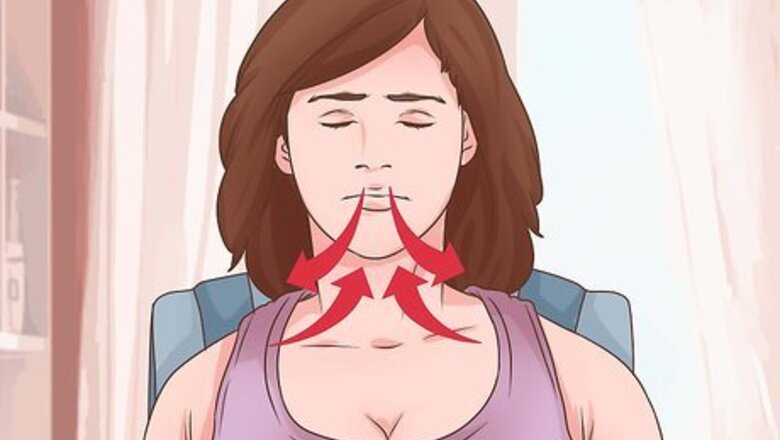
views
X
Trustworthy Source
Harvard Medical School
Harvard Medical School's Educational Site for the Public
Go to source
If you have noticed that your heart rate is high, or if your doctor has told you so, you may be worried. Although human heart rates have some natural variation, an abnormally high heart rate can lead to many serious health conditions, including a stroke, a heart attack, or lung disease. If your heart rate is higher than is healthy, there are some things you can do to lower it naturally.
Doing Breathing Techniques and Meditation

Use breathing techniques to reduce stress. It is widely known that stress can increase your heart rate. When you are stressed, your body releases adrenaline, increasing your heart rate to assist in dealing with the stressor. Breathing techniques relax and calm your body and mind, thereby lowering your heart rate. Sit up straight. Put one hand on your belly and the other on your chest. Inhale deeply through your nose. You should feel the hand on your belly rise, but the hand on your chest should not move. Breathe out slowly, with your mouth barely open. Use your hand on your belly to push air out, if you want. Repeat this exercise 10 times.
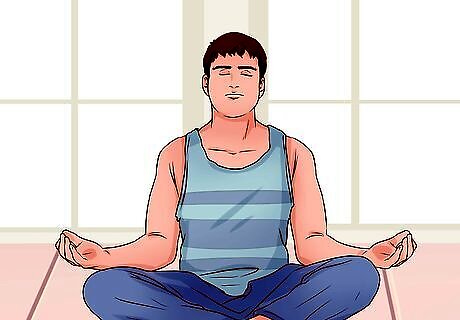
Try meditating. Meditation can be used as a technique to calm the body and mind. It is often used by people suffering from illness or physical problems to attain physical relaxation, mental calmness, and psychological balance. Mindfulness meditation is a simple and effective way to begin a practice of daily meditation: Sit in a comfortable position, whether in a chair, cross-legged, or kneeling. Begin to pay attention to your breathing. Your mind will eventually wander. When you catch your mind wandering, bring your attention back to your own breathing. Don’t stop to dwell on or judge your thoughts. Continue this process for a short time, such as 5 minutes if you are trying it for the first time. Repeat this practice frequently, at least once a day. As you begin to practice mindfulness meditation regularly, you can gradually increase the length of the sessions, if you desire.
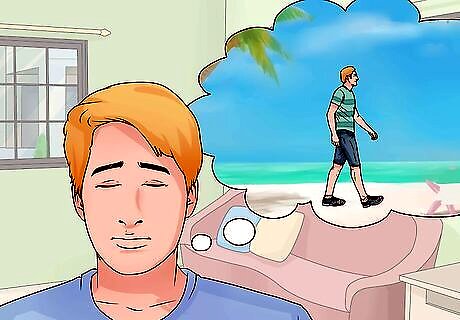
Use guided imagery techniques to relax your mind. Guided imagery is a technique used to help reduce unnecessary worrying and stop anxious thoughts. It can help you focus and relax, decrease the negative impact of stressors, and ultimately lower your heart rate. Try the following technique for 10 to 20 minutes: Prepare yourself for visualization. Avoid watching television, surfing the net, and other stressors. Find a quiet and comfortable place to rest and meditate. If possible, lie down. Start by closing your eyes and taking a few deep, slow breaths. Focus on imagining a setting that you find peaceful and relaxing. For example, imagine yourself at a beach, walking, striding in the sand, with the breeze blowing in your face. Imagine you are gently floating on the water. Then, allow yourself to explore that peaceful place you are imagining. When you are ready to leave, take a few deep breaths and open your eyes.
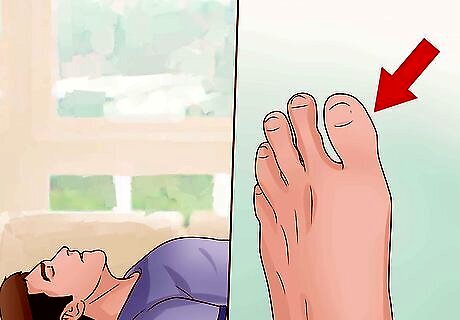
Try progressive relaxation. For this technique, you work on slowly tensing and releasing different muscle groups in your body. It relaxes your body and mind, which can contribute to a lower heart rate. Sit comfortably in a chair or lie down. Tense the muscles in your toes. Hold for 5 seconds, then release and relax for 30 seconds. Work progressively, tensing and releasing other muscles in your body in the same way: your legs, your thighs, your abdomen, your arms, and your neck. You can repeat the exercise by working the muscles from your neck back down to your toes.
Lowering Your Heart Rate with Exercise

Schedule time for exercise. Exercise has innumerable benefits, and lowering your heart rate is chief among them. In the moment, exercise will raise your heart rate. However, over the long term, consistent aerobic exercise can lower your resting heart rate. You can exercise in any way that you are familiar with and reap these benefits. Try exercising for at least 30 minutes per day. If you find it hard to find time to exercise because you get busy during the day, try setting aside time early in the morning before you start any other activities. If you find it hard to set 30 minutes or more at the time aside for exercising, you can even exercise in 2 15-minute blocks at different times during the day and still benefit.
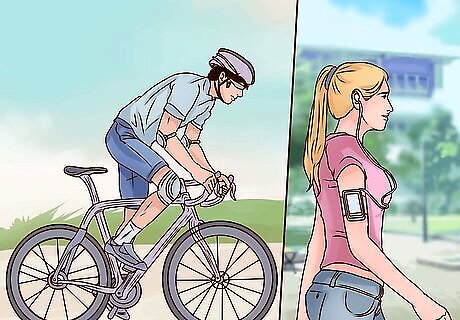
Do aerobic exercises to achieve a slower resting heart rate. A lower resting heart rate is attained when the heart is strong. Aerobic exercise provides cardiovascular conditioning, decreasing the risk of heart disease, lowering blood pressure, and increasing high-density lipoprotein (HDL) or “good cholesterol.” Good aerobic exercises include: Running Swimming Walking Cycling Dancing Jumping jacks
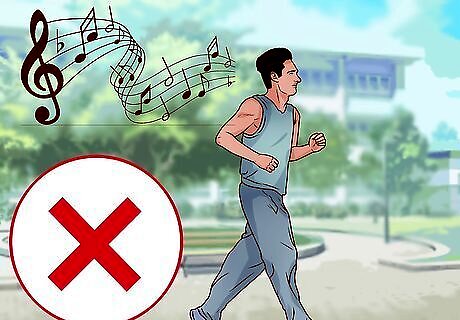
Choose the right exercise intensity to lower your heart rate. Moderate and vigorous exercise have been shown to lower your resting heart rate. You can try a variety of exercises, but make sure they pass the talk/sing test to ensure that they are at the right level of activity: if you can’t talk while exercising, you are working too hard, but if you can sing while exercising, you aren’t working hard enough.
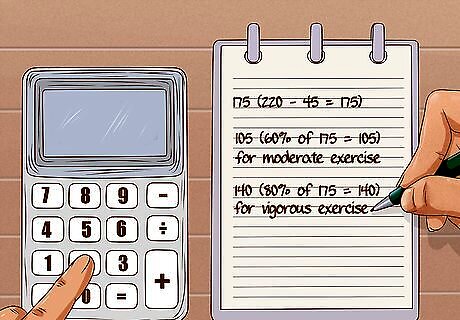
Determine your target heart rate for maximum exercise efficiency. Determining your target heart rate allows you to aim for a certain heart rate range during exercise. This allows you to push your heart to get stronger without dangerously overworking it. First, you must estimate your maximal heart rate by subtracting your age from 220. This is the maximum number of times your heart should beat per minute while exercising. Then calculate your target heart rate: moderate exercise should lead to 50 to 70% of your maximum heart rate; vigorous exercise should lead to 70 to 85% of your maximum heart rate. For example, if you are 45 years old, your maximal heart rate is 175 (220 - 45 = 175). Your target heart rate should be about 105 (60% of 175 = 105) for moderate exercise and 140 (80% of 175 = 140) for vigorous exercise.
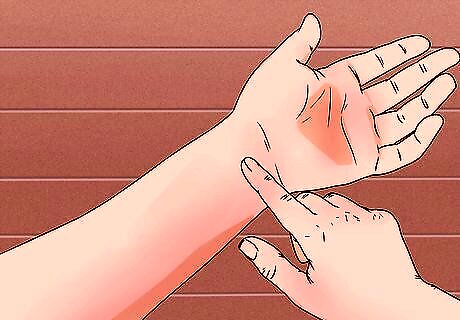
Monitor your heart rate when exercising. Before exercise, take your pulse first, either in your wrist or neck, counting for a full minute with a wristwatch. Or, count for 15 seconds and multiply your pulse by 4. Then, after exercise or during cooling down, take your pulse again. Taking your pulse at regular intervals lets you know whether you are exercising within your target heart range. You can also wear a heart rate monitor or a fitness device (possibly even your smartphone) that will monitor and record your heart rate.
Changing Your Diet
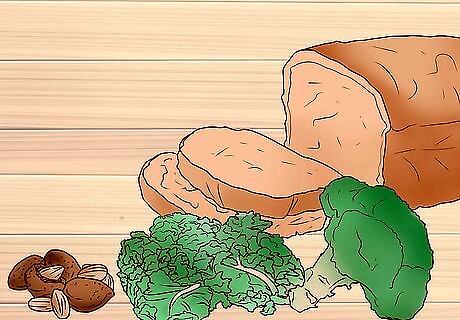
Eat foods high in magnesium to support your vascular health. Magnesium is one of the most essential minerals for maintaining heart health. It plays an active role in the functioning of over 300 enzyme systems in your body, which support the functioning of the heart muscle and the relaxing of blood vessels. Talk to your doctor about the right amount of magnesium for you, since too much can lower your heart rate to dangerous levels. Foods rich in magnesium include: Green leafy vegetables, such as spinach Whole grains Nuts (such as almonds, walnuts, and cashews)
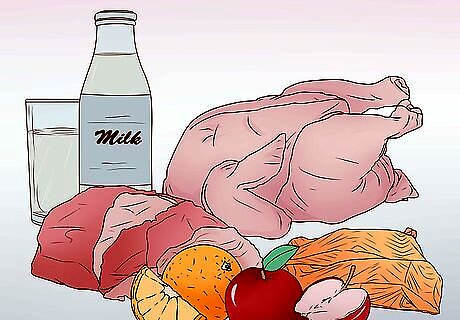
Get adequate amounts of potassium in your diet. Potassium has a significant role to play in your health as it is essential for the proper functioning of all cells, tissues, and organs in the body. Among these roles, potassium impacts your heart rate, and increasing your intake of it can lower your heart rate. Talk to your doctor about the right amount of potassium for you, since too much may slow your heart rate to a dangerous level. Foods rich in potassium include: Meats (beef, pork, chicken) Some fish (salmon, cod, flounder) Most fruits and vegetables Legumes (beans and lentils) Dairy products (milk, cheese, yogurt, etc.)
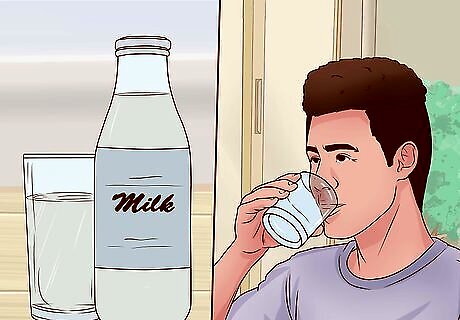
Include calcium in your diet to maintain heart health. Calcium, an electrolyte like potassium and magnesium, is essential for heart health. Your heartbeat’s strength depends very much on the calcium in the heart muscles’ cells. Therefore, to have your heart muscles perform their duty to perfection, it is essential to have the required level of calcium in your body. Good sources of calcium include: Dairy products (milk, cheese, yogurt, etc.) Dark green vegetables (broccoli, kale, collard greens, etc.) Sardines Almond milk
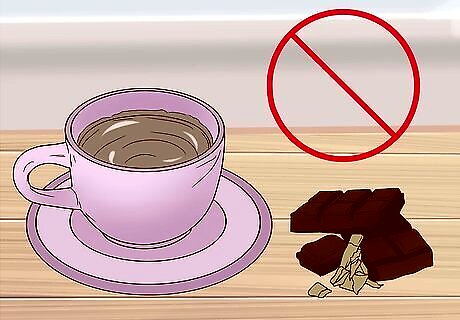
Avoid consuming caffeine. Caffeine is a stimulant that can raise your heart rate. The effects of caffeine can even last for hours after consuming it. For this reason, it is best to avoid caffeine if you are trying to lower your heart rate. Products containing caffeine include: Coffee Black and green teas Some sodas Chocolate
When to Seek Medical Treatment
See your doctor if you experience symptoms of a rapid heart rate. A rapid heart rate, or tachycardia, can have a wide variety of underlying causes, some of which require medical treatment. It can also lead to more serious complications if you don’t get it under control. If you have a rapid heart rate or related symptoms, see your doctor so they can determine what’s causing your symptoms and come up with an appropriate treatment plan. Common symptoms include: Shortness of breath Lightheadedness A feeling that your heart is racing or pounding Heart palpitations, which may feel like your heart is “flopping” or skipping a beat Chest pain Fainting
Get emergency medical attention for severe symptoms. If you experience symptoms such as difficulty breathing, fainting, or chest pain that lasts for more than 2-3 minutes, call emergency services or go to the emergency room. These symptoms could indicate a heart attack or another more serious complication. Other heart attack symptoms include: Pain that radiates into your neck, arm, jaw, or back A feeling of pressure or squeezing in your chest Nausea, indigestion, abdominal pain, or a feeling similar to heartburn Fatigue Dizziness or lightheadedness Cold sweats
Talk to your doctor before attempting home remedies. Before you try to treat your rapid heart rate with diet, exercise, or supplements, talk to your doctor. Depending on your overall health or what’s causing your symptoms, some of these approaches could do more harm than good. Discuss your treatment plan carefully with your doctor, and give them detailed information about your health history and any medications or supplements you are currently taking. Some dietary supplements can interact with other supplements or medications, so ask your doctor what you can safely take. Exercising too strenuously could potentially put dangerous strain on your heart, especially if your rapid heart rate is related to an underlying heart condition. Talk to your doctor about what kind of exercise is safe and appropriate for you.
Get checkups as often as your doctor recommends. If you’ve been diagnosed with a rapid heart rate, it’s important to work closely with your doctor to make sure your symptoms and any underlying conditions are under control. Keep regular appointments with your doctor and follow their home treatment instructions carefully. Let your doctor know if you develop new symptoms or if your symptoms get worse. Don’t hesitate to call your doctor or set up an appointment if you have any questions or concerns, even if you aren’t due for a checkup.




















Comments
0 comment